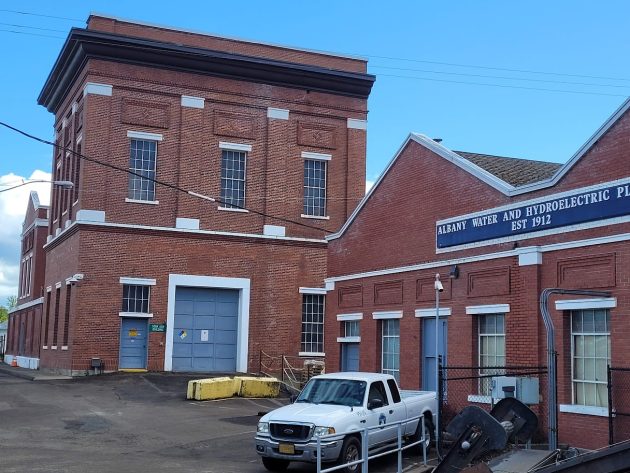
Albany’s Vine Street water treatment and hydroelectric plant was photographed on May 6.
Readers of Albany’s proposed water master plan may get the feeling that the city’s historic water and electric plant on Vine Street is not long for this world.
The city council got a preview of the 226-page master plan in April but has not yet adopted it.
Prepared by consultants in two firms (West Yost, and Brown and Caldwell), the plan recommends that Albany conduct a “viability study” of the Vine Street water treatment plant and hydropower system.
Albany has two water treatment plants, the Albany-Millersburg plant near Scravel Hill built in 2005, and Vine Street built in 1912. Either one can produce all the water Albany needs now, but if one was knocked out, the other one could not meet the demand projected in 2045.
The consultants cite a number of ways in which parts of the Vine Street plant are “noncompliant.” Fixing them all would not be feasible. So their report suggests that Albany consider building a new treatment plant at a different location, along with a big new reservoir that would replace three existing ones.
As for hydropower, the consultants say the turbine needs repairs to perform better. The main issue is corrosion, and fixing it requires taking the turbine apart. However, they say the repairs would cost significantly more than projected revenue from power sales, “suggesting that the investment is not economical for the city,”
They didn’t evaluate the generator, which was commissioned in 2008 and might also need work. Their conclusion is that Albany should consider “decommissioning” the hydro plant.
The draft plan recommends numerous other work in the Albany water system over the next 20 years. Among others, the consultants list improvements or repairs on the Santiam Canal. (They don’t, however, mention putting the 18-mile canal in a pipeline, as the late Councilman Ralph Reid wanted to do for years.)
In all, the consultants estimate the water system needs about $164 million of capital projects over the next 20 years, or $8.2 million a year. From this the average reader might conclude the system has lots of problems.
But in his weekly report to the city council on May 24, City Manager Peter Troedsson wrote:
“Our water system is in excellent shape and fully capable of meeting growth demands with appropriate investment over time. There is no critical water failure, nor is one imminent. Albany is better positioned than many communities due to our redundant plants and well-maintained distribution system.”
It will be interesting, though, to see what future councils do with the recommendation to study replacing the Vine Street plant, a big part of the history of this town. (hh)

From here (on Queen Avenue) to Fourth Avenue, the retaining walls of the Santiam Canal need repairs, according to the draft of a new Albany water plan.

Nice pictures, Hasso. (My standard comment!) Troedsson is a highly-paid city manager…he pulls down the biggest Albany taxpayer-funded salary. He paints things as rosy, of course. He doesn’t want anyone to think the 21.5 million spent on paving Water Street “with gold”…(well, the cost of bricks apparently is golden-like)…could have been saved for water system repairs.
P.S. The beautiful Vine Street water plant (with shoring up to withstand an earthquake) would make a prime apartment building or condos.
Wouldn’t it be nice if the voters thought of this as just another reminder come election time. It’s definitely (past) time for a change. Don’t vote for those who wasted our money (and will continue to do so) on the waterfront projects while letting our streets continue to crumble away.
Wouldn’t it be a total shock if the consultants recommended a few minor repairs and stated that otherwise we’re in great shape? Like what Peter Troedsson said!
Consultants should be studied and rigorously vetted. Who hired them? How much were they paid for this faulty advice? What sort of connections do they have to who might be hired to do this unnecessary work?
Or is it simply a large “grey area” subject to interpretation?
If we’re hiring idiots…..I’m available
The electrical generation system NEVER penciled out economically from the onset. It was all “feel good” BS.
Not counting ANY labor or maintenance, it would have taken 60-80 years to just pay for the equipment, which was purchased in China in a time when the govt. was shutting down dams and manipulating available water flows. GEE, what could possibly happen in the future, DUH!
Any replacement parts are at the whim of China as far as cost, IF EVEN AVAILABLE!
Thank you Hasso. I am pretty sure I requested this report.
Can you summarize immediate plans for the next 5 years? Thanks!
Yeah! Per Craig. Peddle to the metal. Ok? Please!
When ran through our home filtering system the water in Albany has a high level of contaminates. The filtration system needs to be modified to produce healthy water. Having two systems in place is common sense if failures can happen. To maintain a health water system includes monitoring what affects our water before in is even gets to the city’s system. Pollutants from outside sources need to be addressed such chemicals from farming, manufacturing and trash disposal. It is more cost effective to solve problems before they need intervention. The government does help fund clean water measures. The city has put all its efforts into making Albany what they feel is aesthetically pleasing and funding for managing the homeless instead of creating an environment that maintains a healthy all inclusive resident base. Focusing on the positive ways to improve Albany would indirectly help resolve many of the issues it faces. No one wants to support a system that clearly disregards them and their needs.
Next time the council gets together, they need to discuss what the city NEEDS, not want THEY want.